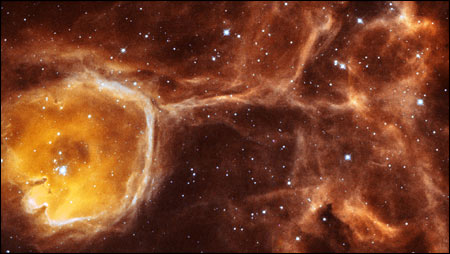The Hubble Space Telescope was able to penetrate a bubble of interstellar gas and dust spreading through a hurricane of particles ejected from a young star. This unnamed neighboring star loses 100 million times more mass than our Sun every second, creating a vortex of accelerating particles
Avi Blizovsky

The Hubble Space Telescope was able to penetrate a bubble of interstellar gas and dust spreading through a hurricane of particles ejected from a young star. This unnamed neighboring star loses 100 million times more mass than our Sun every second, creating a vortex of accelerating particles.
Since the star is surrounded by a mantle of gas, the particle train or solar wind collapses, along with the gas. This process causes a bubble to be pushed out of the type seen in the picture taken by Hubble.
The N44F nebula is one of quite a few interstellar gas bubbles known to us. In the past, structures and water have been observed around massive stars and also around star clusters, where they are called super bubbles. N44F is part of the N44 bubble complex which also contains super bubble.
.
Huge fingers
The bubble parent structure is 1,000 light-years in diameter and has several star-forming regions within it, including N44F along the edge of the superbubble at the center of the complex. The inner wall of the gas cave contains several finger-like columns of cooler dust and gas that are 4-8 light years high.
Similar pillars make up the 'Pillar of Creation' - a famous formation photographed by Hubble in the much closer Eagle Nebula. They were created using ultraviolet radiation from the star and indicate the direction of the energy flow.
The image was taken by Planetary Camera #2, using a filter that isolates the light emitted from the element phosphorus.
As you may recall, about a week ago, NASA Director Sean O'Keefe announced that the space agency would try to send a robotic service mission to rescue the Hubble instead of dropping it into the sea. Such a robotic mission could add another five years to the life of the telescope, which without assistance would end in 2008.
